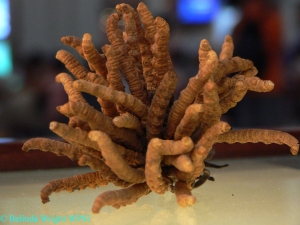Caterpillar Fungus Production and Trade
The caterpillar fungus (Cordyceps sinesis ) is a unique natural resource turned into a valuable medicinal plant that grows in the fertile land of central and eastern Tibet during the months of May to August. Currently around 50% of the Tibetan population in the Chinese so-called Tibet Autonomous Region (TAR) depend their live on this caterpillar fungus. Our research has shown the possibility of a price increase of caterpillar fungus as the production yield has reduced in the current year.
Experts say this year’s production yield has been reduced in many areas of the TAR, leading to financial crises to many Tibetan families. The harvesting period of the caterpillar fungus is from month of May to August and the production yield has been reduced by 50% in NagChu area with sizable reductions in the Chamdo area.
Medro Gungkar suffers a 60% reduction in the production yield as compared to the last year’s harvest; this led to the rise in price from 10 to 30 Chinese Yuan for a single caterpillar. The market price has also risen accordingly and it was estimated that the price will continue to increase.
The sales staff of the Caterpillar fungus shop in Lhasa told the Chinese media that the price of 1kg of Caterpillar which consist of 2000 big pieces was 21000 Chinese Yuan in the end of May and now has risen to 23000 Chinese Yuan per kg. Likewise, the price per kg of another caterpillar fungus has risen from 8000 Yuan to 18000 Yuan.
The production yield is also low in Qinghia region of Tibet. A digger told the media that he is worried he might not be able to pay the rent of the land as the growth of caterpillar is very low this year.
In a nutshell, the production yield of caterpillar fungus in Tibet last year was around 75 tones and this year it reached a mere 40 tones. Digging of the caterpillar fungus has caused reduction in the soil nutrition which leads to malnutrition of the domestic animals directly affecting grassland nomads.
Many of the local residence nomads were doubtful about the recent incidents of epidemic skin disease to the wild life animals could be the effect of over plugging of caterpillar fungus. Environmental experts say that the excessive collection of caterpillar fungus also contribute to the massive desertification on the Tibet plateau by causing holes, cracks, landslides and ultimately ruining the roots of grassland.
This valuable medicinal plant, caterpillar fungus grows only in the high Himalaya regions of Tibet, Nepal and Sikkim which has the average altitude of 4300 meters to 5000 meters above sea level.
Caterpillar fungus is described as a worm in winter and plant in summer and has been that way for centuries, but its medicinal values were discovered by the outside world only in the mid-twentieth century. It has become a custom for many Tibetan nomads and farmers who camp in the mountain valleys and vast grasslands to plug the caterpillar fungus in the month of May to August. Harvesting this fungus has undoubtedly improved the living standard for many Tibetans, but it has done great damage to the environment by depleting the vast grasslands causing floods and desertification.
The general life span of the caterpillar fungus is six years and therefore the natural growth of this plant has been reduced. Due to excessive plugging, the fungus has been rendered an endangered species. This caterpillar fungus has many medicinal benefits such as: reducing liver fats, preventing liver and lung cancer, preventing heart disease and improving stamina and body strength.
The popularity has risen in the global market after the extraordinary performance of three Chinese athletes in 1993, later discovered to be the effect of taking caterpillar fungus in their daily diet. The caterpillar fungus was valued and cherished by the Chinese Emperors and other members of the elite since the sixteenth century.



comment 0